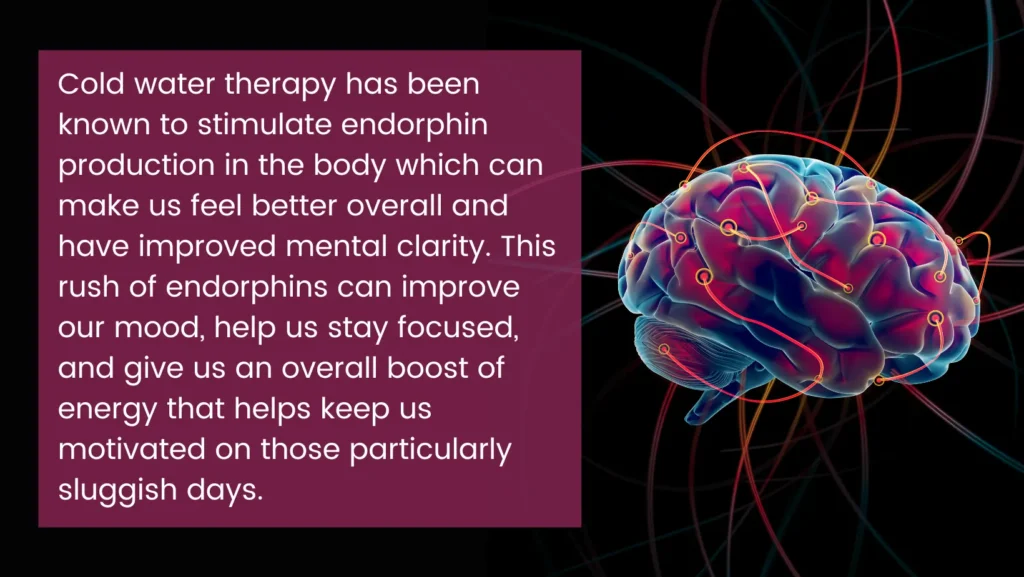Exploring the Chill Factor Ice Baths and the Cool World of Cold Water Therapy
Have you ever considered the invigorating world of ice baths or cold water immersion (CWI)? a refreshing dip in icy water for about 5-15 minutes, a practice akin to cryotherapy, where your body gets a brief exposure to chilly temperatures.
RELATED THERAPY Benefits and Risks of Ice Baths (Cold Water Therapy)

Unraveling the Mechanics: When you step into an ice bath, the cold water prompts a drop in both body and skin temperature. This shift triggers vasoconstriction, narrowing your skin’s blood vessels, redirecting blood to your core in a bid to stay warm. Upon emerging from the frosty soak, vasodilation occurs, expanding the vessels and sending oxygen- and nutrient-rich blood back to your muscles and tissues. This intriguing process may hold the key to reducing inflammation, potentially alleviating pain and muscle soreness, particularly the kind that follows exercise-induced delayed-onset muscle soreness (DOMS).

The Pressure of Cold Water Immersion: Immersing yourself in water not only chills but also applies pressure to your body, known as hydrostatic pressure. This phenomenon diverts blood flow to vital organs like the heart, brain, and lungs, offering an additional supply of oxygen and nutrients to these critical areas.
Diverse Cold Water Therapy Techniques: Ice baths and cold water plunges are just one facet of cold-water immersion. Cold showers, involving standing under the coldest water setting for 5-15 minutes, are a quick way to introduce yourself to cold-water immersion. Contrast water therapy takes a dynamic approach, alternating between cold and hot-water immersion, often used for sports injuries. Then, there’s the Wim Hof Method (WMH), a holistic approach incorporating breathing exercises, cold exposure, and meditation, potentially contributing to stress reduction and improved cardiovascular function.
Delving into the Benefits: Cold water therapy unfolds a range of potential health benefits by modulating body temperature and enhancing circulation.

- Pain Relief: The application of ice is known to narrow blood vessels, reducing swelling, pain, and inflammation after an injury. Ice baths follow a similar principle, offering potential relief upon exiting due to increased blood circulation.
- Muscle Soreness: A review of studies indicates that cold-water immersion post-exercise aids in reducing muscle pain and improving recovery. While conflicting research exists, some suggest a potential decrease in muscle mass and strength after cold-water immersion.
- Mood and Alertness Boost: Limited yet intriguing research proposes that cold-water immersion may enhance mood. Studies note improved self-esteem and decreased tension and anger after a 20-minute soak in 55-degree seawater.
Navigating the Risks: However tempting the icy plunge may be, it’s not without its risks. Potential side effects include cold-induced rash (cold panniculitis), cold shock response, hypothermia, ice burn, and nerve damage. The impact varies based on factors such as health, immersion time, and temperature.
Considerations Before Taking the Plunge: Before you embrace the icy waters, a conversation with your healthcare provider is wise, especially if you have specific health conditions. Conditions like cold uterica, heart or lung issues, and Raynaud’s syndrome can heighten risks, making professional advice crucial.
Mastering the Art of Ice Bathing: Taking an ice bath can be done at home or in designated therapy centers. For a DIY approach, your bathtub is the go-to. Ensure you have a large towel nearby, wear light athletic clothing, and fill the tub with cold water (add ice for desired temperature). A timer set for 10-15 minutes is your guide. As you lower yourself in, starting with the waist and progressing to the neck, focus on relaxation and deep breaths.
Tips for a Successful Ice Bathing Experience: If you’re a newcomer, acclimating with cold showers is a smart start. Begin with shorter durations, gradually increasing over weeks. Consider immersing only part of your body initially, progressing to more extensive coverage.

Duration Dilemma: While there’s no universal rule, studies suggest that 5-15 minutes in cold water may yield positive results for muscle recovery. Frequency varies, with some opting for a few sessions a week, especially after physical activity.
RELATED ARTICLE Vitamin Insight, A Holistic Approach to Leg Cramp Management
Listening to Your Body: Prolonged exposure to cold water comes with caution. Warning signs like excessive shivering, numbness, or unusual skin conditions should prompt a swift exit. These symptoms could indicate hypothermia or frostbite, emphasizing the need to pay attention to your body’s signals.
In a Nutshell: Ice baths, a subset of cold-water immersion, offer potential perks like reduced muscle soreness and improved mood. However, limited research and associated risks warrant careful consideration. A dialogue with your healthcare provider becomes crucial, ensuring a safe and informed approach, especially if you have underlying health conditions.
